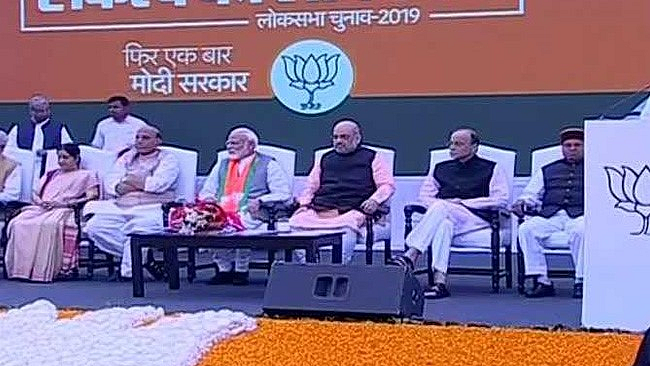BJP deserts ‘Vikas’, drops ‘Development’, returns to Hindutva and Ram temple
Ram Temple was not on its agenda in 2014. But five years after unsuccessfully promoting the faux ‘Vikas Purush’, BJP is back to its old bag of tricks

Dropping all pretence to any development and progressive agenda, Bharatiya Janata Party signalled in its ‘Sankalp Patra’ (Pledge rather than a manifesto) a return to its old Jana Sangh agenda.
What the document implies is that voters looking for development may have to ensure that BJP led by Modi-Shah stay in power till 2047, when India would become a fully developed country.
Dismissing lightly all the tall claims and promises made before 2014, BJP has chosen to go beyond the five-year tenure of a Lok Sabha and awakened the aspirations of the voter to a distant 2047. Mr Modi will be 97 years old in 2047. Possibly he aspires to beat his Guru L K Advani who aspired to occupy the PM’s chair till well past the age of 80.
Releasing BJP’s ‘Resolution’ document (for that is what Modi/Shah duo preferred to describe it), Prime Minister claimed in his address that the Resolutions were focused on people’s requirements. But they seemed more sharply focussed on BJP’s core Hindutva constituency betraying the fear of some shift even in this core vote bank of the BJP spread across the country.
That’s why there is clear reiteration of pushing ahead with the Citizenship Amendment Bill, passed by the Lok Sabha in its last session, in the second week of January this year. This Bill which proposes to legalise migration of Hindus, Jains, Sikhs and Buddhists from Pakistan, Bangladesh and Afghanistan, aims at changing the demography of the North East, in particular Assam both communally and culturally.
The plan is clearly to settle Hindus and Buddhists from Bangladesh in Assam, Manipur, and Arunachal Pradesh as well. Simultaneously the Hindus and Sikhs from Pakistan and Afghanistan too would be welcomed to settle elsewhere, presumably in western and northern India.
The proposal caused tremendous disaffection in the North East, where people already suspicious of settlers from other states like Bengal and Bihar, initiated a process of ethnic cleansing. The National Register of Citizens has excluded four million people, mostly Indian citizens, both Muslims and Hindus working in Assam, who have been segregated and interned in detention centres, pending a final decision on their citizenship. In the process they have been denied their right to franchise.
The Prime Minister and the BJP also appear to have been impressed by US President Donald Trump’s resolve to keep people from neighbouring Mexico out by building a wall, notwithstanding the refusal of the American Congress (Parliament) to support this misadventure. Little wonder then that the Resolution proposes modern fencing between India and Bangladesh to keep away “infiltrators.”
There have been three main issues that the saffron brigade have agitated in favour since the days of the Jana Sangh. First is Articles 370 and 35A of the Indian Constitution which provide a distinct identity to the people in Jammu & Kashmir, guaranteed in the Accession document whereby the Indian state guaranteed the Kashmiris the right to maintain their separate identity by not allowing “outsiders” to settle there.
This rankled the saffron brigade from the days of the Jana Sangh. The first Jan Sangh president Shyama Prasad Mukherjee led an agitation against this in the 1950s and died of a heart attack there. The Resolution says,“We reiterate our position since the time of the Jana Sangh to the abrogation of Article 370,” and adds, “We are committed to annulling Article 35A of the Constitution of India as the provision is discriminatory against non-permanent residents of Jammu and Kashmir,” clearly reassuring the Hindutva enthusiasts to fulfil their long desired aspiration to go and settle in Kashmir and alter its Muslim majority demography.
Muslim males enjoying the privilege of four wives, though such men are in a miniscule minority, and walking out of marriages through the expeditious move of triple talaq have also not gone down well with the Hindutva brigade for being denied such a privilege to them. Therefore, the repeated demand for a Uniform Civil Code has been there on record since 1986, when Advani became the BJP president and gave the BJP a distinct Hindutva stamp. So, Modi’s Sankalp Patra predictably says, “BJP reiterates its stand to draft a Unform Civil Code…”
Lastly, BJP has reiterated its renewed resolve for a Ram temple in Ayodhya which catapulted the BJP first to the main Opposition party and then to the position of the ruling party.
In the last general election the BJP studiously avoided the Ram temple issue, encouraging Modi Bhakts to project him as a modern politician focussed on development. In fact, the then BJP spokesperson Ravi Shankar Prasad had said then that while Ram Mandir was an article of faith with the BJP, it was not on its agenda. Times have changed since then.
Follow us on: Facebook, Twitter, Google News, Instagram
Join our official telegram channel (@nationalherald) and stay updated with the latest headlines
